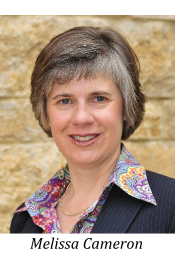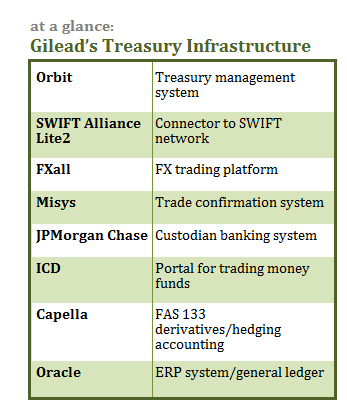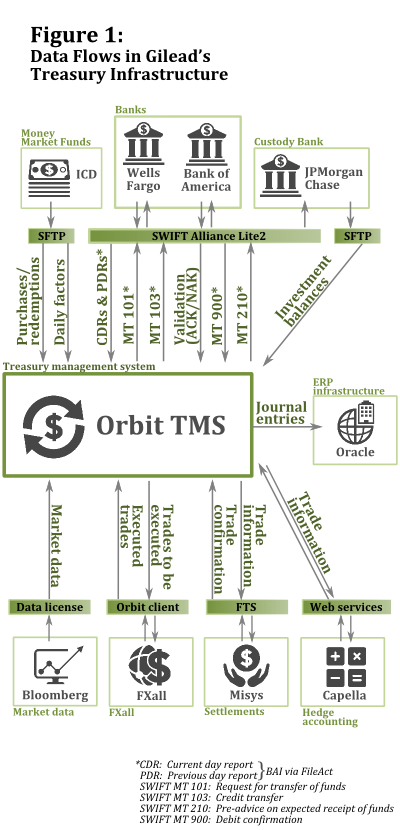 Twelve months ago, the treasuryteam at Gilead Sciences, Inc., a fast-growing biopharmaceuticalbusiness that develops and produces treatments for some of theworld's deadliest diseases, faced some critical challenges. Thecompany brings in close to $10 billion in annual revenue throughoperations in more than 30 countries. Yet its small treasury staffwas spending more time on transaction processing than on analysis,and manual data entry put the company at risk for errors.
Twelve months ago, the treasuryteam at Gilead Sciences, Inc., a fast-growing biopharmaceuticalbusiness that develops and produces treatments for some of theworld's deadliest diseases, faced some critical challenges. Thecompany brings in close to $10 billion in annual revenue throughoperations in more than 30 countries. Yet its small treasury staffwas spending more time on transaction processing than on analysis,and manual data entry put the company at risk for errors.
Treasurer Brad Vollmer decided to revamp hisdepartment's technology infrastructure to automate many of histeam's core duties. He worked with MelissaCameron, a Deloitte principal who specializes in treasury,to integrate cash management and foreign exchange (FX) systems fromforecasting to settlement to accounting. Now many of the previouslytedious treasury tasks are automated, reducing the chances oferrors and freeing up Vollmer's staff for more value-added work.Treasury & Risk sat down with Vollmer andCameron to discuss the project and its results.
|T&R: What were the challengesthat your treasury team faced in your legacy environment?
|Brad Vollmer: Well, our treasury opsteam, which handles FX, cash management, capital markets, andplanning, consists of eight people. For a company with a market capapproaching $90 billion, that's a pretty small treasury staff. Wehave approximately 130 bank accounts with 18 banks in 30 countries.We have more than $3 billion worth of securities invested in moneymarket funds, government notes, and corporate securities, both inthe U.S. and offshore. We have $7.5 billion in debt, which includesa revolver and convertible notes, as well as straight debt. And ourFX portfolio, which we use to hedge risks in 12 differentcurrencies, is worth $4 billion. So the treasury ops team needs tobe very efficient.
|T&R: I take it that your treasuryprocesses weren't especially efficient before?
|BV: We had the common problem that a lotof our processes were manual and very labor-intensive. Multiplepeople would have to enter the same data into different systems.This meant that, number one, our processes were potentially proneto error. And secondly, we were spending a lot of time doingnon-value-added work again and again for the same wire or the sametransaction. It was all very cumbersome. We wanted to move up thevalue chain to straight-through processing so that our treasury opsteam could spend more time on analytics instead of processing.
|T&R: And that was because theinformation wasn't automatically consolidated in one place? Youguys had to go in and manually get it?
|BV: Yes. For example, to determine ourglobal cash position, our colleague in Europe would log into ourwire systems, pull all the data, and put it in a spreadsheet. Thenhe'd have to log into our ICD portal and do the same thing for allour money fund investments. He'd grab all that information, put itin a spreadsheet, and send it to the U.S. Then the U.S. team woulddo the same for North America and put it all together in a report.They did that once a week, and it took a good day's worth ofwork.
|Melissa Cameron: Brad, by the time yougot it, it was out of date.
|BV: That's right. After all that effort,the information would be a day old by the time I got it.
|T&R: What were some otherprocesses that needed automating?
|BV: One was just sending and receivingwire transfers. Treasury would get a request for a wire. We wouldenter it in a tracking spreadsheet so we knew what was sent. Wewould enter it in our wire system. And then we would send the sameinformation to accounting, who would re-enter it into their system.Even for a share repurchase wire, the information was flowing indifferent directions and re-entered a number of times.
|An even better example was our process for FX trades. Our FXforecasting process is pretty good, but we were very inefficient inprocessing FX trades. We would key the data into Bloomberg toexecute the trades. Then we would put that same data into ourconfirmation system, Misys, where it would be confirmed. Then we wouldre-enter it all again into our wire systems for settlement. Wewould send the same information to an accounting system calledCapella for ASC 815 purposes, and when the accounting would comeout of Capella, someone would manually input it into the G/L[general ledger]. So the same data was re-entered over and overagain. Some of these steps did involve spreadsheet uploads, butthey still required someone to touch the data. We wanted to getaway from that, both to save people time and to reduce the riskthat mistakes could be made.
||T&R: It's clear why you wanted toimprove your treasury processes. How did you get the ball rolling,though, on making a wholesale change?
|BV: Well, when I arrived here, Gilead wasin the midst of an ERP [enterprise resource planning] project,where we moved from JD Edwards to Oracle. As soon as that projectended, we wanted to start an automation project in treasury. At thevery beginning, we got IT involved, as well as accounting and otherareas of finance.
| MC: Brad also made areally good call to get internal audit [IA] to help right from theget-go, to make sure they were embedded in the overall project,including the design process, identifying the key controls.Typically, internal audit comes in at the back end, and they eitherapprove or say, 'No, go back and do some extra work.' Before thesystem went live, Brad had the comfort of knowing that IA hadsigned off on the controls. Additionally, we didn't have to redoany design elements because internal audit got involved late in theprocess. This is a best-practice approach.
MC: Brad also made areally good call to get internal audit [IA] to help right from theget-go, to make sure they were embedded in the overall project,including the design process, identifying the key controls.Typically, internal audit comes in at the back end, and they eitherapprove or say, 'No, go back and do some extra work.' Before thesystem went live, Brad had the comfort of knowing that IA hadsigned off on the controls. Additionally, we didn't have to redoany design elements because internal audit got involved late in theprocess. This is a best-practice approach.
T&R: What were your key criteriafor your new treasury solution?
|BV: We agreed that we were looking for asystem that would provide flexibility in customizing it to make itas useful as possible for us. I think sometimes the big treasuryservice providers can be too bureaucratic. You have to fill out achange request and wait to see if it gets approved, which mighttake months. We wanted a treasury service provider that had actualtreasury experience, but that could make decisions quickly, with atool that is flexible enough and robust enough that we can makechanges and move on. We selected the cloud-based Orbit treasurymanagement system.
|During our ERP implementation, we had been talking withDeloitte. I've known Melissa for a long time, and I have a lot offaith in her and her team. We didn't use Deloitte to help us selectthe system, but once we had made decisions about the direction wewanted to go, Deloitte helped validate those decisions.
|MC: We did give Brad and his team somepointers and perspective before they locked down that decision. Butit was nice that when we jumped into this project, we knew what wewere going to do. The only thing that came up a bit later wasGilead's decision to use SWIFT Alliance Lite2 to connect to the SWIFTnetwork.
|T&R: So, how does an FX trade nowwork?
|BV: Now we upload our exposures intoOrbit, which automatically exports them into FXall. Once a trade isexecuted in FXall, Orbit automatically ships it to Misys. Then,once it's been confirmed in Misys, it comes back into Orbit with a'confirmed' status. Next, Orbit actually generates the wires tosettle the trade. Instead of rekeying any data, someone just pushesa button and tells SWIFT Alliance Lite2 to release the wires. Thenthat same information flows automatically into Capella, ouraccounting system for FAS 133. At month-end, it comes back intoOrbit, where it all gets consolidated, and Orbit interfacesdirectly with our Oracle G/L. At every step, the data movesautomatically.
| MC: From a broadperspective, I see this as leading practice. Treasury teams thatare doing all these things manually are exposing their organizationto a lot of operational risks. From a control perspective, thissystem is a huge step forward for the Gilead treasury team. I thinkall companies with $1 billion or more in revenue should really beaiming toward system automation like this.
MC: From a broadperspective, I see this as leading practice. Treasury teams thatare doing all these things manually are exposing their organizationto a lot of operational risks. From a control perspective, thissystem is a huge step forward for the Gilead treasury team. I thinkall companies with $1 billion or more in revenue should really beaiming toward system automation like this.
T&R: What about the weeklyreports on your cash position? What do those look liketoday?
|BV: I can tell you right now, on anygiven day at any given time, what our global cash positionis—almost down to the penny. What used to be an all-day event nowhappens with just a click of a button.
|T&R: Can you estimate how muchtime your staff is saving on the weekly cash reports, FX trades,and other treasury activities?
|BV: Well, it's hard to quantify the timebecause we didn't let anyone go. What we did is re-task them.They've moved up the value chain because they're spending more timeon analytics, on solving the real challenges we face, rather thanjust keying in data. That said, on a monthly basis, we're probablysaving around four days of time on FX processing activities. Andthen on a weekly basis, we've eliminated about a day of busy workbecause the staff no longer has to produce the cash report.
|So we are achieving time savings. But the key for me is, I sleepbetter at night because I know the chance of a fat finger causingproblems with the data is much lower.
|MC: And it's real-time.
|BV: Right. I get information in real timenow. I don't have to wait for the weekly cash report to know wherethe cash is. The same goes for foreign exchange. If somethinghappens with a counterparty, I can run a report at my desk, rightaway, to see what our exposure is to that bank. That's huge.
|And there's one more important benefit: The automated treasurysolution is much more scalable. Gilead is growing incredibly fast,and we're moving into a bunch of new markets. Because we're workingdirectly with SWIFT, our system is bank-agnostic. When we need toscale, we can just pick the best bank in the region, set up anaccount, and we're live pretty quickly.
|T&R: How long did it take to rollout this solution?
|BV: We got this done in seven and a halfmonths, from the kickoff until the solution was live, includingcontracting with SWIFT and our relationship banks. We went into itwith the assumption that this would not be like every othertreasury implementation. We made sure to scope it right up front sowe could move as quickly as possible. We had really good projectmanagement from Deloitte, with things running in parallelstreams.
||T&R: What kinds of activitieswere you doing in parallel that normally might happenserially?
|MC: We used an agile approach to softwaredevelopment. We were very discerning about determining what Gileadreally wanted, and what they didn't need. And as we configured theOrbit solution, we would essentially be in design sessions withOrbit, with Gilead's core treasury, accounting, and internal auditteam. Meanwhile, parallel actions were going on around defining andcleaning up static data and contracting with the banks around SWIFTmessages.
|BV: We had different streams going. So aswe worked on SWIFT, we didn't let that slow down the FX side or ourwork with ICD or even Misys. We knew what we needed todo, and we didn't let the queue back up.
| MC: Everyday was a new adventure, and projects often don't happen like that.They're often very structured, where you need to dot the i's andcross the t's on everything in one phase before you can move intothe next phase. But this time we moved very fast. I think theproject would have taken 40 percent longer, maybe more, if we hadwe gone with a larger vendor with a less agile approach.
MC: Everyday was a new adventure, and projects often don't happen like that.They're often very structured, where you need to dot the i's andcross the t's on everything in one phase before you can move intothe next phase. But this time we moved very fast. I think theproject would have taken 40 percent longer, maybe more, if we hadwe gone with a larger vendor with a less agile approach.
T&R: Gilead was an early adopterof SWIFT Alliance Lite2. How has that worked out?
|MC: Gilead was one of the first companiesin the world to implement Alliance Lite2. It has been a phenomenalsuccess.
|BV: I'm a big fan of SWIFT AllianceLite2. What it does is it gives you one throat to choke. You'redealing directly with SWIFT, and it is all cloud-based. I don't seeany downside to it.
|MC: Clearly the market has moved so thatadvanced corporate treasury departments are going to pick either aservice bureau or SWIFT Alliance Lite2 for bank connectivity,wherever possible. Because SWIFT is owned by over 100 banks, itoffers a strong business continuity advantage.
|Business continuity is also an issue when you're choosing atreasury system solution provider, but I think an in-house solutionrarely makes sense these days. For a midsize to large businesswhere it might be a challenge to get the right IT resources tosupport a treasury management system, it makes a lot more sense tohave a hosted solution. If you go with a cloud-based solution, youcan either have a dedicated environment or one that gets upgradedwhen everyone else gets upgraded. There are pros and cons to bothof those approaches. But a cloud-based treasury management systemis a smart solution for companies that don't want to build a big ITorganization for treasury.
|
Complete your profile to continue reading and get FREE access to Treasury & Risk, part of your ALM digital membership.
Your access to unlimited Treasury & Risk content isn’t changing.
Once you are an ALM digital member, you’ll receive:
- Critical Treasury & Risk information including in-depth analysis of treasury and finance best practices, case studies with corporate innovators, informative newsletters, educational webcasts and videos, and resources from industry leaders.
- Exclusive discounts on ALM and Treasury & Risk events.
- Access to other award-winning ALM websites including PropertyCasualty360.com and Law.com.
*May exclude premium content
Already have an account? Sign In
© 2024 ALM Global, LLC, All Rights Reserved. Request academic re-use from www.copyright.com. All other uses, submit a request to [email protected]. For more information visit Asset & Logo Licensing.







